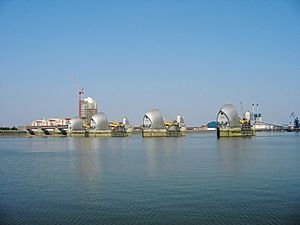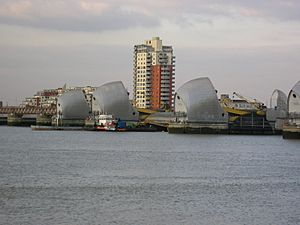Thames Barrier facts for kids
The Thames Barrier is a huge movable wall built across the River Thames in London. It is the second largest of its kind in the world. Its main job is to stop floods from reaching central London. It protects the city from very high tides and big storm surges coming from the North Sea.
The barrier is only closed (raised) when the tide is high. When the tide goes out, it is lowered to let the water flow away. The barrier is located between the London Borough of Newham and the Royal Borough of Greenwich. It was built after a terrible flood in 1953 that caused a lot of damage and loss of life.
Contents
Why London Needs the Barrier
London can be flooded easily. This happens when a big storm in the Atlantic Ocean moves towards the North Sea. The storm pushes a lot of water into the North Sea. This water then gets squeezed into the narrow Thames Estuary, like water in a funnel.
If this storm surge happens at the same time as a very high tide, the water levels in the Thames can become dangerously high. Engineers watch the river levels carefully. They also look at how much water is flowing down the river from areas west of London. This helps them decide when to close the barrier.
Rising Water Levels
The risk of flooding has grown over many years. The sea level has been slowly rising. Also, the land in the south and east of Britain is slowly sinking. This makes high tides even more dangerous for London.
Past Floods
Before the barrier, London faced serious floods. In 1928, 14 people died in a Thames flood. Then, in 1953, a huge flood in the North Sea killed 307 people in the UK. These events showed how important it was to protect London.
At first, it was hard to plan a barrier. This was because ships needed a large opening to reach the London Docks. But later, new ways of shipping cargo meant a new port was built further away. This allowed for a smaller barrier with gates the same size as those on Tower Bridge.
How the Barrier Works
The Thames Barrier is closed when two things happen. First, high tides are expected in the North Sea. Second, the river flow is high at Teddington Lock, which is where the tidal part of the river begins. If water levels might go above 4.87 meters (about 16 feet) in central London, the barrier is closed.
The process of closing the barrier starts about 9 hours before a dangerous high tide arrives. Messages are sent to stop river traffic. Smaller gates along the Thames are closed first. Then, the main barrier gates are closed one by one.
The gates stay closed until the water level downstream (towards the sea) is the same as the water level upstream (towards London).
Dealing with River Floods
Sometimes, heavy rain west of London causes a lot of floodwater to flow down the Thames. This water can't easily escape to the sea at high tide because the tide pushes against it.
When the river is flooding upstream, the barrier gates can be closed shortly after low tide. This creates a large empty space behind the barrier. This space acts like a giant reservoir. It can hold the extra floodwater coming from upstream. Most river floods will not fill this space during the few hours the barrier needs to be closed. If the barrier wasn't there, the high tide would fill this space instead. Then, the floodwater could spill over the river banks in London. About one-third of the barrier closures up to 2009 were to stop flooding caused by heavy rain.
Closures and Incidents
The Thames Barrier has been closed more often than first expected. In the 1980s, it closed 4 times. In the 1990s, it closed 35 times. In the first ten years of this century, it closed 75 times. The number of closures is increasing quickly.
On October 27, 1997, a ship called MV Sand Kite crashed into one of the barrier's piers. The ship was sailing in thick fog. It started to sink and dumped its cargo of 3,300 tonnes of gravel. It sank on top of one of the barrier's gates. This meant the gate could not be closed because it was covered in gravel. Experts estimated that if a flood had happened, the damage could have cost around £13 billion. The ship was removed in mid-November 1997.
The barrier was closed twice on November 9, 2007. This was because of a big storm surge in the North Sea. This surge was similar to the one in 1953. The biggest flood danger was along the coast north of the Thames Barrier. But the winds calmed down a bit. Also, the storm surge did not perfectly match the high tide at the barrier.
The Future of the Barrier
The Thames Barrier was built to protect London from very large floods. It was designed to handle rising sea levels based on what scientists knew in the 1970s. Even with global warming causing sea levels to rise faster, recent studies suggest the barrier could still work well until about 2060 or 2070.
In 2005, some experts suggested building a new, much larger barrier. This new barrier would be 16 kilometers (10 miles) long. It would stretch across the Thames Estuary from Sheerness in Kent to Southend-on-Sea in Essex.
Images for kids
See also
 In Spanish: Barrera del Támesis para niños
In Spanish: Barrera del Támesis para niños













